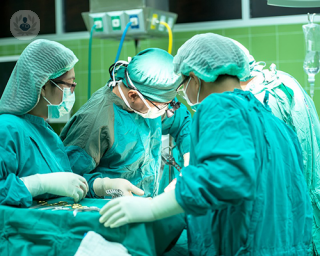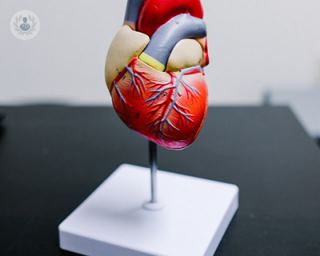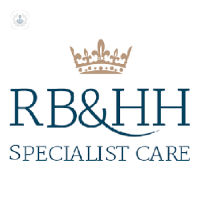What is coronary surgery?
Heart surgery, also known as coronary artery bypass surgery or a coronary bypass surgery, is a type of surgery used to divert the blood and avoid blocked coronary arteries. The blockage may affect one or more of the arteries that carry blood to the heart, and may be partial or total (stenosis).

When arteries are blocked, the blood that flows through them doesn’t have enough oxygen for the heart to function as it should. This is when the first symptoms start to appear.
The main aim of the surgery is to supply blood to areas that have a lack of blood flow due to coronary lesions. The surgery is done under general anaesthetic and lasts between four and seven hours.
Why would you do it?
This kind of surgery is recommended for people who have one or more blocked arteries, which can put the supply of oxygenated blood to the heart at risk.
If the coronary arteries are blocked, the myocardium doesn’t receive enough blood, which could cause ischaemic heart disease, coronary artery disease, or angina.
It is frequently done on patients who have several vessels affected after a heart attack in which percutaneous revascularisation was not achieved.
What does it involve?
The surgery will attempt to divert the blocked artery blood flow of the using grafts from blood vessels. The procedure can be done through the saphenous vein or through the thorax.
The patient will be given general anaesthetic. In many of these operations, a circulation pump is used to perform the work of the heart and lungs during the procedure.
When making a diversion, the specialist chooses a vein and it is grafted around the blocked area.
The saphenous vein is generally used. An incision is made on the inner leg, placing one end of the graft in the coronary artery and the other in the aorta.
How to prepare for it
When preparing for heart surgery, the patient should be in close contact with their specialist and follow any instructions given.
If the patient is a smoker, the specialist will request that they stop smoking at least two weeks before the operation. Smoking has been linked to breathing problems and blood clots.
The area that will be operated on will be disinfected before the operation, and if needed, shaved.
Post-operative care
After surgery, the patient will remain in the hospital for around a week. The very day of the operation, they will go to the intensive care unit (ICU), where their heart rate and function will be closely monitored.
After around a week in hospital, the patient will start to recover normalcy in their life. The specialist may recommend walking or swimming to regain strength. The most important thing is to make lifestyle changes, such as limiting fat intake, quitting smoking, and exercising regularly.
If the patient’s job isn’t physically demanding, they will be able to return to their daily routine within five or six weeks after the operation. If the patient has a physically demanding job, they will have to wait longer.
Alternative treatments
Alongside pharmaceutical treatment, the main alternative treatment is coronary angioplasty.
In this procedure, a catheter is placed through a blood vessel —through the wrist or groin— which is used to open arteries that have had stenosis, so that blood can flow more freely to the heart. A stent, a small metal tube, may be used to keep the artery open.
11-13-2012 11-23-2023Coronary surgery
Mr Jorge Mascaro - Cardiothoracic surgery
Created on: 11-13-2012
Updated on: 11-23-2023
Edited by: Aoife Maguire
What is coronary surgery?
Heart surgery, also known as coronary artery bypass surgery or a coronary bypass surgery, is a type of surgery used to divert the blood and avoid blocked coronary arteries. The blockage may affect one or more of the arteries that carry blood to the heart, and may be partial or total (stenosis).

When arteries are blocked, the blood that flows through them doesn’t have enough oxygen for the heart to function as it should. This is when the first symptoms start to appear.
The main aim of the surgery is to supply blood to areas that have a lack of blood flow due to coronary lesions. The surgery is done under general anaesthetic and lasts between four and seven hours.
Why would you do it?
This kind of surgery is recommended for people who have one or more blocked arteries, which can put the supply of oxygenated blood to the heart at risk.
If the coronary arteries are blocked, the myocardium doesn’t receive enough blood, which could cause ischaemic heart disease, coronary artery disease, or angina.
It is frequently done on patients who have several vessels affected after a heart attack in which percutaneous revascularisation was not achieved.
What does it involve?
The surgery will attempt to divert the blocked artery blood flow of the using grafts from blood vessels. The procedure can be done through the saphenous vein or through the thorax.
The patient will be given general anaesthetic. In many of these operations, a circulation pump is used to perform the work of the heart and lungs during the procedure.
When making a diversion, the specialist chooses a vein and it is grafted around the blocked area.
The saphenous vein is generally used. An incision is made on the inner leg, placing one end of the graft in the coronary artery and the other in the aorta.
How to prepare for it
When preparing for heart surgery, the patient should be in close contact with their specialist and follow any instructions given.
If the patient is a smoker, the specialist will request that they stop smoking at least two weeks before the operation. Smoking has been linked to breathing problems and blood clots.
The area that will be operated on will be disinfected before the operation, and if needed, shaved.
Post-operative care
After surgery, the patient will remain in the hospital for around a week. The very day of the operation, they will go to the intensive care unit (ICU), where their heart rate and function will be closely monitored.
After around a week in hospital, the patient will start to recover normalcy in their life. The specialist may recommend walking or swimming to regain strength. The most important thing is to make lifestyle changes, such as limiting fat intake, quitting smoking, and exercising regularly.
If the patient’s job isn’t physically demanding, they will be able to return to their daily routine within five or six weeks after the operation. If the patient has a physically demanding job, they will have to wait longer.
Alternative treatments
Alongside pharmaceutical treatment, the main alternative treatment is coronary angioplasty.
In this procedure, a catheter is placed through a blood vessel —through the wrist or groin— which is used to open arteries that have had stenosis, so that blood can flow more freely to the heart. A stent, a small metal tube, may be used to keep the artery open.


How soon can I do exercise following heart surgery?
By Mr Neil Roberts
2024-12-26
Leading consultant cardiothoracic surgeon, Mr Neil Roberts explains how soon you can return to normal activity following heart surgery, and how increased exercise improves your rate of recovery. See more


Coronary artery disease: bypassing to beat CAD
By Professor Olaf Wendler
2024-12-20
Coronary artery disease (CAD) is on the rise, and with it the risk of chronic angina, heart failure and heart attacks. Expert heart surgeon Professor Olaf Wendler specialises in treating CAD, and helped to pioneer arterial coronary artery bypass grafting (CABG) – a surgical technique to treat this condition. See more


Beating heart coronary bypass surgery explained
By Mr Alberto Albanese
2024-12-17
Beating heart coronary bypass surgery offers a shorter recovery time, fewer risks and better outcomes for cardiac surgery patients in comparison to more traditional bypass surgery techniques. We've invited renowned consultant cardiothoracic surgeon Mr Alberto Albanese to explain how this innovative procedure works and how patients with coronary artery disease can benefit. See more


Coronary artery disease: surgical solutions
By Professor Olaf Wendler
2024-12-14
Coronary artery disease (CAD) is the most common type of heart disease and can be potentially lethal. It can cause chest pain, shortness of breath, and even heart attacks. However, there are options for treatment. Leading heart surgeon and CAD expert Professor Olaf Wendler explains the surgical options to combat this condition and potentially save your heart. See more
Experts in Coronary surgery
-
Mr Shahzad Raja
Cardiothoracic surgeryExpert in:
- Aortic root surgery
- TAVI (transcatheter aortic valve implantation)
- Aortic valve replacement
- Coronary surgery
- Heart valve surgery
- Minimally invasive cardiac surgery
-
Mr Neil Roberts
Cardiothoracic surgeryExpert in:
- Coronary surgery
- Coronary heart disease
- Aortic valve replacement
- Heart valve surgery
- Heart bypass
- Atrial Fibrillation
-
Mr Paul Modi
Cardiothoracic surgeryExpert in:
- Mitral valve repair (minimally invasive)
- Coronary bypass surgery
- Atrial Fibrillation
- Coronary surgery
- Heart valve surgery
- Aortic valve replacement (minimally invasive)
-
Ms Rashmi Yadav
Cardiothoracic surgeryExpert in:
- Mitral valve repair
- Atrial Fibrillation
- Endoscopic coronary artery bypass surgery
- Coronary heart disease
- Heart valve surgery
- Coronary surgery
-
Professor Mohamed Zeinah
Cardiothoracic surgeryExpert in:
- Mitral valve repair
- Coronary bypass surgery
- Atrial Fibrillation
- Coronary surgery
- Heart valve surgery
- Aortic valve replacement (minimally invasive)
- See all

77 Wimpole Street
77 Wimpole Street
77 Wimpole Street, London. W1G 9RU
No existe teléfono en el centro.
By using the telephone number provided by TOP DOCTORS, you automatically agree to let us use your phone number for statistical and commercial purposes. For further information, read our Privacy Policy
Top Doctors

Royal Brompton and Harefield Hospitals
Royal Brompton and Harefield Hospitals
Royal Brompton Hospital, Sydney Street, Chelsea, London. SW3 6NP
No existe teléfono en el centro.
By using the telephone number provided by TOP DOCTORS, you automatically agree to let us use your phone number for statistical and commercial purposes. For further information, read our Privacy Policy
Top Doctors

The Alexandra Hospital - part of Circle Health Group
The Alexandra Hospital - part of Circle Health Group
Mill Ln, Cheadle, SK8 2PX
No existe teléfono en el centro.
By using the telephone number provided by TOP DOCTORS, you automatically agree to let us use your phone number for statistical and commercial purposes. For further information, read our Privacy Policy
Top Doctors
-
77 Wimpole Street
77 Wimpole Street, London. W1G 9RU, W1G Marylebone LondonExpert in:
- Homecare
- Cardiology
- Preventive cardiology
- Cardiovascular disease
- Respiratory diseases
- Hypertension
-
Royal Brompton and Harefield Hospitals
Royal Brompton Hospital, Sydney Street, Chelsea, London. SW3 6NP, Central LondonExpert in:
- Arrhythmia
- Cardiology
- Diagnostic Imaging
- Respiratory diseases
- Breathlessness
- Hypertension
-
The Alexandra Hospital - part of Circle Health Group
Mill Ln, Cheadle, SK8 2PX, CheadleExpert in:
- Hip
- Cardiology
- Shoulder and elbow
- Paediatrics
- Foot and ankle
- Knee
- See all
- Most viewed diseases, medical tests, and treatments
- Minimal access surgery (keyhole surgery)
- Aortic aneurysms
- Medicolegal
- Robotic surgery
- MRI
- Interventional cardiology
- Lung cancer
- Atrial fibrillation ablation
- Coronary bypass surgery
- Hyperhidrosis








